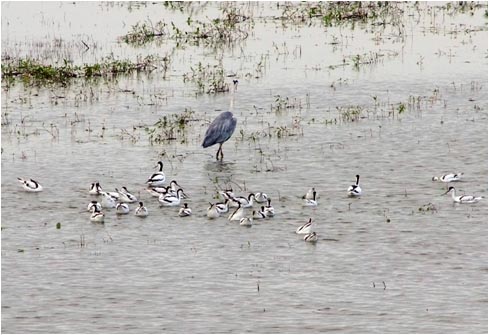Central-Tisza Landscape Protection Area
After the flood control measures of river Tisza and its tributaries the character of the Great Hungarian Plain has changed completely. The wilderness of wetlands before the training operations, with dimensions probably found today only in the delta of the Danube, has gone for over a hundred years.
Drainage and breaking up of marshlands, cutting off the large meanders of the river have changed the character of the Great Hungarian Plain dramatically. It was then that the fate of hard-wood riparian forests was sealed too. Altered hydroperiod has had an adverse effect on the recruitment of Oak-Ash-Elm riparian forests. They have been progressively replaced by faster-growing Willow-Poplar riparian forests. What has developed was a secondary, less diverse, more desolate landscape to meet, first and foremost, economic interest. Nonetheless, many representatives of the one-time wildlife found their habitat in the riparian woodland, floodplain grasslands, oxbow lakes and marshy meadows. Let us discuss each of these biotopes to see what has been left of them for today.
Historical relics of human culture can be found in Szatmár-Bereg from the earlier Paleolithic Age through Neolithic-, Copper- and Bronze Age to the Roman Age and the time of the Hungarian settlement. More than 20 churches came down to us from the Middle Ages. Their stylistical characteristics cover many styles from the Roman to the late Gothic style. The belfries of the region having Transylvanian effect are dated from the earlier times. One of the most famous graveyards of the country is the one of Szatmárcseke where strange-shaped so-called wooden grave posts guard the rest of the dead and bring the visitors to muse.
The increasingly lessening so called "jungle orchards" cherish the memory of a traditional economic system forming mixed standed forests together with the native tree species in the flood area of the rivers. Many of the ancient fruit types can be found in their remains, the different types of plums are of high priority. It was used for desiccation, jam preserving and distillation of brandy. These are the main activities of Alföld carried out on the highest level. In the huge vineyards of the downs of the "Big-Mountain of Tarpa" and Kaszony mountain wine was produced competing with Tokaj region in their quality. There are two industrial historical art relics in this area connected to agriculture. One is the watermill in Túristvándi; the other is the horse-driven mill of Tarpa. Both can be seen in a working and good state.

A lot of prominent people were born here or had unforgettable experiences of this land. Here lies Ferenc Kölcsey who was also born in this place. The works of Sándor Petőfi and Lőrinc Szabó based on the experiences gained here are also famous. Among others Ottó Herman and Zsigmond Móricz were well-known notabilities of this land. Zsigmond Móric's house is still standing in Tiszacsécse. Endre Ady studied, Dezső Szabó was a teacher in the schools of nearby towns.
Hardwood gallery forests have altogether disappeared from the Mid-Tisza region by our days. Their sites had first been occupied by native Willow-Poplar riparian forests, then even these have been increasingly replaced and squeezed out by plantations of hybrid Poplar cultivars, unable to provide neither food nor breeding ground and shelter for the original fauna.
Willow-poplar riparian forest, wherever they have remained, form an uneven-width fringe along both river banks, surround the floodplain meadows and oxbow lakes. The undergrowth consists mainly of Dewberry, Common Nettle and the introduced False Indigo. On decaying tree trunks covered by mosses we may come across with the protected Narrow Buckler Fern and at patches less densely covered by the undergrowth with Broad-leaved Helleborine, one of the orchid species occurring in the landscape conservation region.
The protected Rose Beetle, Forest Cutterpillar-hunter, Lesser Stag Beetle, Rhinoceros Beetle,Walnut Longhorn Beetle, Ullrich's Ground Beetle represent the highly diverse invertebrate fauna.
Of the 50-60 nesting species only the most characteristic and/or the most valuable (from a nature conservation aspect) should be mentioned. Species under strict protection include 4 pairs of White-tailed Eagle, 4-5 pairs of Black Stork, 3-4 pairs of Black Kite and, occasionally, 1-2 pair(s) of Saker Falcon. Occupants of the Heron colonies are primarily the Grey Herons and theCormorants, and in smaller numbers are the Night Herons. These Heron colonies are found at Pély, Óballa and Tiszaalpár, generally within a reserve under strict protection. Of the other protected species commoner ones are the Common Buzzard, Goshawk, the Tawny Owl, theGreen Woodpecker and the Black Woodpecker, and the array of the songbirds comprises countless Nightingales, Blackcaps, Long-tailed Tits, Robins, Chaffinches and River Warblers.
Besides birds, a number of mammals have found excellent habitats there. The most densely overgrown parts are preferred by Wild Boars, while the sparser, grove-like spots attract the Roe Deers. The hollows, cavities and cracks of old trees are occupied by Bats. Predators are in the first place the Beech Marten, the Weasel, the Red Fox and the Wildcat.
These can show a high degree of similarity to riparian forests but can be regarded as a very different type on the basis of origin. All occur along the non-reclaimed (floodplain) side of the dykes. This suggests at once that these woods have not established naturally but were planted for breaking the wind and waves into the pits left behind the earthwork (gravel, sand and clay removal) for dyke construction. Their canopy composition is roughly the same as that of the soft-wood riparian forest.
Of the protected plants the largest growth sites of a Tansy species, the Chrysanthemum serotinum and the Hungarian Horse-raddish (Armoracia macrocarpa) are stretching along the edges of these woods.
Despite its artificial origin, this type of wood with all its old trees of huge canopies harmonises with the landscape of the Mid-Tisza, thus supports an outstanding value for landscape patterns.
Besides riparian forests these are relatively expansive areas. Lower-lying spots are occupied by associations composed mainly of Cyperoids (sedges and rushes) while the higher sites are by Meadow Foxtail (Alopecuretum) communities. This plant association of 100-140 species includes no outstanding, protected plant curiosity. The only protected species there is Blue Clematiswhose yellow-tufted blue flowers open throughout the summer.
Owing to the frequent inundations its constant fauna is not exceptionally rich. It is made up mainly of species that can adapt to sudden changes associated with shifts in hydrology. Temporary pools and shallows remaining after the inundations attract Waders, Ducks, smaller or larger flocks of the Grey Heron, Spoonbills, Little Egrets and Great White Egrets, White Storksand Black Storks.
Normally situated along the edge of the floodplain meadows and also parallel with the bed of the Tisza, which suggests well-embanked, long-abandoned old dead arms (backswamp). They receive their water supply during inundations. The highly embanked, shallow basins can detain not much water, thus tend to dry up by mid-summer. Characteristic plant species are the Schoenoplectus lacustris, the Great-sweet-grass, and the Purple Loosestrife. Shallow, fast-warming waters are ideal breeding sites for amphibians, though rather frequent is the Grass Snake.
Of the birds the Little Bittern, Moorhen, Coot, less often the Waterrail, Snipe, Bittern and the strictly protected Ferruginous Duck keep nesting. However, this area is important for birds not just as a nesting site but also as a feeding ground. Besides many small fishes one often founds the Mud Loach.
Where the littoral sand ends will begin the underwater world of the river, an empire hidden so thoroughly from the eyes of man. Its one-time fantastic richness in fish has all gone, though fishermen living in the nearby villages can still lead a fair life. Except for 5, all the 37 fish species occurring in the Tisza are native. Of the 26 protected fishes of Hungary 10 live in the Tisza, the relatively frequent being Zingel and the Stripped Ruffe.
Besides the native river mussels the introduced Zebra Mussels have become abundant. Detailed studies in recent years revealed a very considerable population of the Yellow Gomphe a European curiosity.
With respect to the invertebrate fauna of the Tisza one should necessarily mention the Long-tailed Mayfly, named "kérész" in Hungarian at many places even today. The elder generation may recall its fabulous swarm flights from their childhood. At that time its swarming around mid-June was a familiar sight. Many millions of small larvae swarm from dark underwater holes toward the surface. After some minutes masses of shred exuvia were carried away by the water and the air became full of the whizzing noise of tiny wings. The forthcoming mating demanded an enormous price. Tens of thousands of larvae sheding away their skins on the water surface were eaten up by fish. Water seemed to be boiling with restless fins. Clouds of greedy birds swooped down on emerging mayflies. But all these had no apparent effect. One wave after the other, hundreds of thousands emerged to the surface and those appearing in late afternoon made the air condensed. Through milliards (no overstatement) of transparent wings outlines of the opposite bank could be seen just obscurely. By the time of sunset remains of the exhausted insects formed a carpet on the water surface, no longer rippled by fins of hungry fish. On the branches of trees along the banks crowds of full, satisfied Swallows, Warblers, Flycatchers and Thrushes were heaving.
The permanent and temporary exhibitions at Damjanich Museum in Szolnok inform us about the lives of people in the region, from the prehistoric times up to our days. Who are interested in the artifactual and written mementos of the flood control project of the Tisza should not hesitate to visit the Museum of Waterworks at Millér, equipped in the building of a past-century steam pump and declared an industrial history showroom. There also displayed are old steam-engines and pumps. In the Museum of Geography at Tiszaföldvár visitors are welcome to see exhibitions mostly of natural geography, archaeology, ethnography and local cultural history.

Historic monuments. Nearly every church at the settlements of the Tisza-part have been historic or listed buildings. A detailed list would be too lengthy, yet some should worth a specific mention:
- Roman catholic church, Tiszasüly. Built in a gothic style in 1490.
- Calvinist church, Tiszaroff. Built in 1755. Its special feature is a separated bell-tower built in 1726, a design being very unusual in the region.
- The calvinist church of Tiszabura was originally built on Gothic ruins but was rebuilt in 1806.
- "Csonkatorony" (broken or incomplete steeple), Fegyvernek. Built in a gothic style around 1480.
- The franciscan cathedral in the city center of Szolnok was built in a baroque style at several phases, from 1736 to 1758. The Oath Chapel on the corner of Ady Endre street and Chapel street was completed a little earlier, in 1749.
We must also mention the synagogue built in a romantic style in 1899, now serving as an art gallery and concert hall after many decades of vicissitudes.
Reminders of the flood control of Tisza
Even on a country-wide scale the steam pump at Tiszasüly is a unique apparatus, produced in 1878 with the original British steam engine and pump, but complemented in 1888 with parts made in Hungary. In addition and also in a unequaled manner it has endured intact and in working order.
The Milléri Pump Station at Szolnok was built in the period 1895-1898. Having been put out of operation its mechanism was disrupted thus today it is out of order. The station building accommodates the Waterworks Museum mentioned earlier.
The alleged premises of the "sword and crown" scene, associated with King Andrew I. and Prince Béla in 1059 is signed with an monolith only at Tiszavárkony. In 1514 the army of Dózsa crossed the Tisza at the ferry of Várkony, and many young men joined it from the village Varsány situated on the opposite side.
The "battle of Cibakháza" was fought on the Tisza-part near the village on February 24, 1849, where general Leininger himself was imprisoned for a while
The natural values of the Mid-Tisza territory extend over the present borders of the landscape conservation region. The section between Tiszaug and Csongrád holds a very rich flora and fauna, splendid galery forests and oxbow lakes. Of the strictly protected species regular brooders are the White-tailed Eagle, the Black Stork, the Black Kite and occurs the Otter as well. High bluffs look like huge wasp's nests in conjunction with the multitude of nesting hollows of the Sand Martin, and there is a crowdy colony of Herons hidden in the canopies of Poplar trees on the bank at Tiszaalpár.
For the completion of the Mid-Tisza Landscape conservation region this area has been proposed for protection. By the by, the section in the town's administration was declared protected already in 1995. Should protection be declared for the whole section we can safely state: natural values of the Mid-Tisza region have been provided with a full-scale protection.















